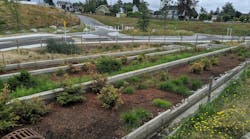San Francisco Battles Industrial Pollutant
Counties and cities in the San Francisco Bay Area may face hundreds of millions of dollars in annual storm water costs to eliminate industrial chemicals called PCBs from runoff, under recently adopted state water board pollution limits.
The San Francisco Regional Water Quality Control Board (SFRWQCB) adopted the first-ever mass limit on PCBs entering the bay in response to health concerns regarding people eating PCB-laden fish. The manufacturing of PCBs was banned in 1979, but the chemicals persist in soil and water and continue to wash into water bodies.
The new regulations require that PCBs entering the Bay must be reduced from about 34 kg annually to no more than 10 kg over the next 30 to 35 years. Tainted storm water flows are the largest contributor and thus the main focus of the reduction efforts.
City and county storm water programs will have to fund the removal costs, meaning property owners will feel a financial impact through increased utility fees. Each program must cut its PCBs contributions from 20 to 2 kg per year.
“It’s going to be a challenge,” said Tom Mumley, assistant executive officer for SFRWQCB. “This is to protect people who eat fish from the Bay.”
Pilot projects will find PCB hotspots on land and divert storm water runoff for treatment in sewage plants. SFRWQCB will evaluate the efforts to determine which measures should be required of county and municipal storm water programs. Once in place, these measures may cost the counties and cities up to $400 million annually, according to board engineers’ estimates.
California Chamber of Commerce representatives have complained of high costs, and the San Fransico Baykeeper and Clean Water Action groups have argued the program lacks well-defined deadlines and cleanup goals. “I feel we’ve got to start somewhere,” said Regional Board Chairman John Muller. “It’s not perfect.”
Source: Inside Bay Area

